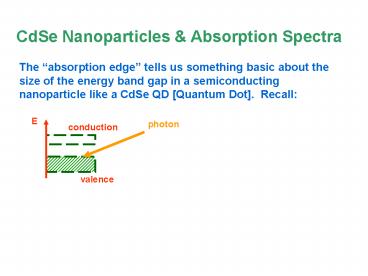CdSe Nanoparticles PowerPoint PPT Presentation
1 / 21
Title: CdSe Nanoparticles
1
CdSe Nanoparticles Absorption Spectra
The absorption edge tells us something basic
about the size of the energy band gap in a
semiconducting nanoparticle like a CdSe QD
Quantum Dot. Recall
E
photon
conduction
valence
2
CdSe Nanoparticles Absorption Spectra
The absorption edge tells us something basic
about the size of the energy band gap in a
semiconducting nanoparticle like a CdSe QD
Quantum Dot. Recall
e-
E
E
photon
conduction
conduction
valence
valence
e
3
CdSe Nanoparticles Absorption Spectra
The absorption edge tells us something basic
about the size of the energy band gap in a
semiconducting nanoparticle like a CdSe QD
Quantum Dot. Recall
e-
E
E
photon
conduction
conduction
valence
valence
e
A conduction band electron is bound to a valence
band hole
an exciton
4
1
20 nm
40 nm
CdSe
0
345 365 388 412 443 477 517 564 620 690
(nm)
The optical absorption data (D.M. Mittleman,
Phys. Rev. B, B49, p. 14435 (1994), as quoted in
Poole and Owens (figure 4.20). Note Above, the
figure has been reversed to put low wavelength
(high energy) on the left side.
5
1
20 nm
Note This graphs scale is linear in energy (not
wavelength)!
40 nm
CdSe
0
345 365 388 412 443 477 517 564 620 690
(nm)
The optical absorption data (D.M. Mittleman,
Phys. Rev. B, B49, p. 14435 (1994), as quoted in
Poole and Owens (figure 4.20). Note Above, the
figure has been reversed to put low wavelength
(high energy) on the left side.
6
1
20 A
40 A
CdSe
0
345 365 388 412 443 477 517 564 620 690
(nm)
The optical absorption data (D.M. Mittleman,
Phys. Rev. B, B49, p. 14435 (1994), as quoted in
Poole and Owens (figure 4.20). Note Above, the
figure has been reversed to put low wavelength
(high energy) on the left side.
7
Dan Sullivans CdSe QD absorption data, April 2006
8
1
20 nm
(Blue)
40 nm
(Orange)
CdSe
0
345 365 388 412 443 477 517 564 620 690
(nm)
The optical absorption data (D.M. Mittleman,
Phys. Rev. B, B49, p. 14435 (1994), as quoted in
Poole and Owens (figure 4.20). Note Above, the
figure has been reversed to put low wavelength
(high energy) on the left side.
9
Absorption of blue wavelengths will make the
nanoparticles appear orange. Absorption of orange
through blue wavelengths will make the
nanoparticles appear yellow.
10
Absorption of blue wavelengths will make the
nanoparticles appear orange. Absorption of orange
through blue wavelengths will make the
nanoparticles appear yellow.
To better understand how the CdSe nanoparticles
absorb UV-Vis light, we need to consider the
excitonic energies in more detail. Band
structure of the CdSe QD before an exciton is
created
E
Empty conduction band
Band gap
Filled Valence band
11
Absorption of blue wavelengths will make the
nanoparticles appear orange. Absorption of orange
through blue wavelengths will make the
nanoparticles appear yellow.
To better understand how the CdSe nanoparticles
absorb UV-Vis light, we need to consider the
excitonic energies in more detail. Band
structure of the CdSe QD after an exciton is
created
E
Empty conduction band
Band gap
Filled Valence band
12
Absorption of blue wavelengths will make the
nanoparticles appear orange. Absorption of orange
through blue wavelengths will make the
nanoparticles appear yellow.
To better understand how the CdSe nanoparticles
absorb UV-Vis light, we need to consider the
excitonic energies in more detail. Band
structure of the CdSe QD after an exciton is
createdbut this is not quite right
E
Empty conduction band
Band gap
Filled Valence band
13
This picture (previous slide) just shows a free
electron created in the conduction band and a
free hole created in the valence bandthis
picture doesnt show any binding energy between
the electron and hole. Binding energies are
typically negative.
14
This picture (previous slide) just shows a free
electron created in the conduction band and a
free hole created in the valence bandthis
picture doesnt show any binding energy between
the electron and hole. Binding energies are
typically negative. IF a bound electron-hole
pair is created THEN it will have an energy lower
than the energy of the free electron free hole
(thats why bound states are more stable than
free states).
An occupied exciton state (lower than the lowest
conduction electron state).
Binding energy of the exciton.
An unoccupied electronic state.
15
Binding energies (in meV) of excitons in various
semiconducting materials
C. Kittel, Introduction to Solid State Physics
(8th edn, 2005)
16
Conduction Band
Eg
Excited exciton levels
Eg Eex
Valence Band
17
Conduction Band
Eg
Excited exciton levels
Eg Eex
Absorption lines
Valence Band
18
Intensity
Wavelength (nm)
400
800
Eg energy gap
19
Intensity
CdSe QD
Wavelength (nm)
400
800
Eg Eex effective energy gap
20
Intensity
Spectrum without excitons
KCl QD excitons introduce a bigger effect due to
large exciton binding energies
Wavelength (nm)
400
800
Eg Eex effective energy gap
21
Effect of an exciton level on the optical
absorption in GaAs at 21 K. The energy gap is
1.521 eV and the exciton binding energy is 0.0034
eV C. Kittel, Introduction to Solid State
Physics (8th edn., 2005).

